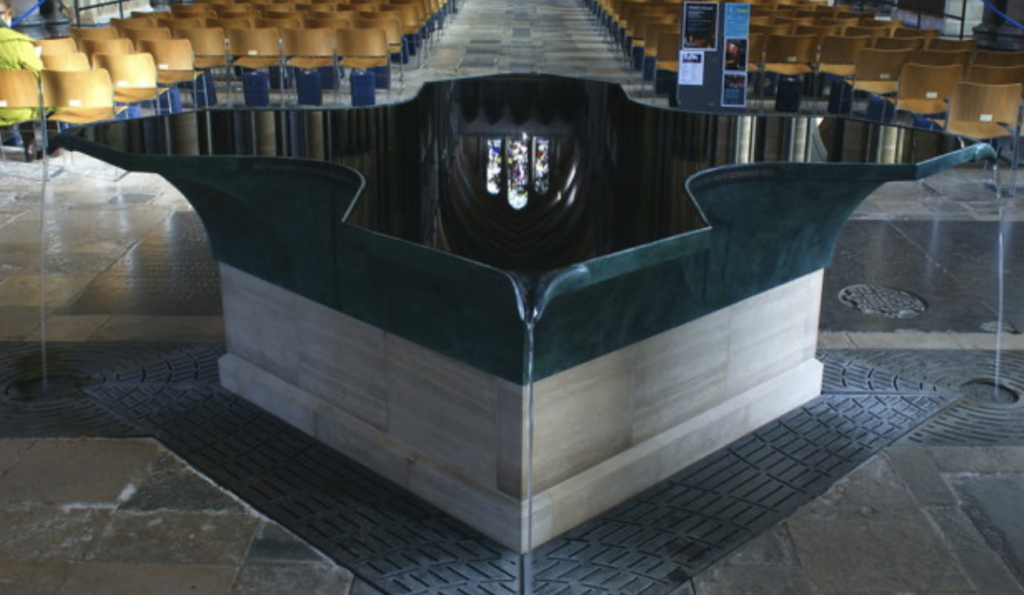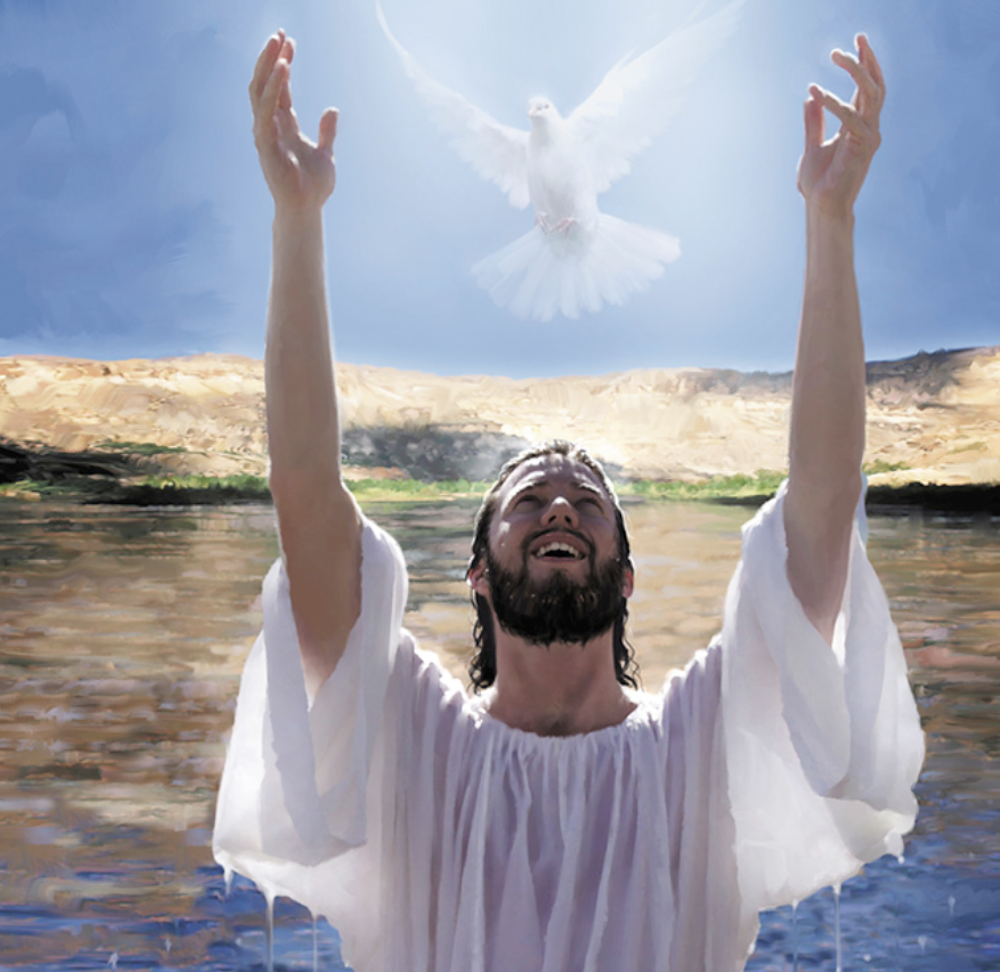
This week’s lectionary reading focusses upon a text we have partially considered during Advent. There, we wondered about pancakes in the desert. Now we’ll focus upon the baptism (Mark 1:4-11). Why baptise Jesus?
John already has quite a reputation as ‘the baptiser’ – I can imagine such a title such as wrestler, all with neon lights… Obviously this is his main skill or charism. And plenty of folk are flocking to him from throughout Judea – so not a Tier 4 area.
We know from Luke’s Gospel about his birth, so closely entwined with Jesus’s birth, and that John was a prophet – possibly the first in 400 years of apparent ‘silence’. He was not one to mince his words, declaring that Herod’s marital dalliances were not above the law, something that would result in John’s untimely death.
There’s clear demarcation that Jesus is one (or two..) above John, in any one’s comparison. When, in Mark’s Gospel it reads “not worthy to stoop down and untie the thing of his sandals” – there’s much to understand by such language. Here’s a comparison of that text from different New Testament books – only Mark mentions ‘stooping down’.
+--------------+--------+-------+--------+------------+ | | Stoop? | Act? | Thong? | Status? | +--------------+--------+-------+--------+------------+ | Matthew 3:11 | no | carry | no | not fit | | Mark 1:7 | yes | untie | yes | not fit | | Luke 3:16 | no | untie | yes | not fit | | John 1:27 | no | untie | yes | not worthy | | Acts 13:25 | no | untie | no | not worthy | +--------------+--------+-------+--------+------------+
In those days. Jews would probably have worn sandals rather than shoes, but it was the task of a slave to untie the footwear after a long day of travelling. John appears not to be even worthy of being Jesus’ bond-servant.

Baptism
In Mark 1:8-9, we see that Jesus is baptised by cousin John in the River Jordan. Although Luke and John’s Gospel account omit the Baptism, in Matthew’s Gospel (Matthew 3:13-15) John has to be persuaded, after an argument about some Pharisees. Now John the Baptist (Mark 1:4) has already made his argument that he proclaims a baptism of repentance for the forgiveness of sins. But without any Angelic fanfare, Jesus is baptised in Mark 1:9. Why did he need baptism? Why baptise Jesus?
Why are we baptised?
Historically the Church has baptised people, predominantly when as babies, so that their sin can be washed away, and for this immersion of the person was typically considered. This is prevalent in Baptist Churches where immersion pools are used – preferably heated? – or for some denominations to go to the seaside. Oddly, when we look to define the word baptism our dictionaries offer the accepted understanding of the word today, not when first coined. Think how the meaning of the word ‘gay’ has changed in recent decades.
It is very difficult, it would seem, to directly translate baptismo from the Greek to English. Dale offers a definition as “whatever is capable of thoroughly changing the character, state, or condition of any object, is capable of baptizing that object: and by such change of character, state, or condition does, in fact, baptize it.” Oops where’s the water?

Later Churches took to immersion, then dipping, then sprinkling the subject with holy water.
Baptism through the Ages
Baptism is a rite of passage, of birth, of new birth. It is one of the Sacraments: of which there are 2 in Methodism, including Communion. This significant word defines the difference between an ‘ordinance’ and a sacrament. The ordinance is our present response to God’s act or grace: it is our action. Whereas, with a sacrament, it is God doing something first, and we then respond. So, why baptise Jesus?; did Jesus need to respond?
A question may be whether, if God does something at Baptism, do we need to respond? What if a child is baptised but later does not follow the Christian faith, has the baptism ‘failed’? Or is it that God’s promise of love will always be there for us?
Another question might be whether we needed any faith before baptism. If so, any existing faith is symbolised in the baptism – akin to adult baptism; or could be demonstrated by the act of baptism; or is given as a gift at baptism – akin to child baptism; or the ‘baptism’ itself calls us to faith. What do you think?
There’s also that understanding that Baptism, within infant dedication, brings belief – perhaps wrongly – whereas confirmation brings belonging. I say belief within baptism may be incorrect as believing, as we have seen in the reading from John’s Gospel speaks of repentance, trust, not solely ‘head belief’. So, why baptise Jesus? Did Jesus need to repent?
Baptism has also evolved over time: from the Jewish ritual washing (also seen with the Muslims); to proselyte (new believers) baptism in Judaism; John’s baptism involving repentance for all people – Jews and Gentiles; and to circumcision and covenant (Colossians 2:11-13).
Why do we Baptise?
John the Baptist baptises Jesus: but who baptised John?

Did Jesus baptise anyone? If we read John 3:22, the answer would be Yes; but move forward to John 4:2 and the answer is No.
We are told to baptise all in the name of the Trinity (Matthew 28:19). Here we see a change in the theme of baptism. In the New Testament we have an understanding that through baptism there is a dying and rising with Christ (Romans 6:3, Colossians 2:12), or we are joined to the body of Christ (Acts 2:41), we may receive the Holy Spirit (Acts 2:38), there’s the washing away of sin and the receiving of forgiveness (Acts 22:16), and new birth (John 3:5). Phew!
Early Church Baptism
At the turn of the first Century after Christ’s birth, in a document known as the Didache, the baptism must be in running water using the words of the Trinity (of the Father, and of the Son, and of the Holy Spirit). The water was preferably to be running and cold but, just in case, any water was ok – as long as you used the Trinitarian words.
The clothes of the baptised would be removed – by the Deacon – , and the body anointed with oil, followed by immersion – three times each preceded by the questions: Do you believe in the Father, in the Jesus, in the Holy Spirit? After the baptism you would be given a white garment and be ‘spiritually sealed’ by the sign of the cross.
Fonts – and not Comic Sans
Initially there was the font in the floor, where people could walk in from one direction, be immersed, and exit in the opposite direction – symbolising moving on from sin. By the 5th C fonts became higher, above the ground and had less water. By the 20th C, fonts were generally pedestals with the capability of holding sufficient water to just about dip the child.
They generally did have 8 sides though. One side for every day of the week and then the 8th side for the first day of the new week- it was a new beginning after all! They may also have lids on the fonts – so to ensure that people did siphon off some of the Holy Water! And yes, some have a plug for the water to drain away – but where?

Easter was often used as a good time for Baptisms, using the period of Lent as a time of theological reflection, or a course known as the Catechism. Pentecost was also considered a good time for Baptisms – now anytime is good!
Although Philip baptised the Ethiopian Eunuch in the nearest water source (Acts 8), baptisms were heavily influenced by a 4-5th C influential cleric – Augustine. Here, the concept of ‘Original Sin‘ was developed. [Compare that with ‘Original Blessing‘]. Thereafter, whereas many people would delay baptism until their death bed – suggestive that they could do what they wished, you know the things plundering etc, and then seek forgiveness at the very last moment. With Augustine, children were then seen as ‘guilty’ at birth, so child baptisms became popular, or seemingly necessary.
So?
So why baptise Jesus? Jesus was without sin, so no repentance required. Jesus was already with God, is God. His baptism confirmed his identity as the Messiah, and demonstrated that willingness to be as us, part of humanity. “Jesus modelled a key step, baptism, in the life of every believer.”
As Methodists, God offers a blessing upon the one whom is to be baptised. It is a one-time all-time blessing. It is there before we even thought about being baptised, or our parents did. It’s called Prevenient Grace.
In my opinion, Baptism works through that action of God. Whether we accept that offer is up to us.
What are your thoughts?
There was some conversation this week regarding the Camel fashion accessory used by John the Baptist. Many of us, including myself, felt that this could have been quite harsh to the touch. We may well be quite wrong!
Here are two sites which strongly suggest that Camel Hair is quite the thing, de rigour perhaps.
https://www.cashmere.org/facts.php
and here’s an 1816 advert describing Cashmere as Camel:

So is Baptism relevant to us today?
Baptism was always seen, in the early days of Church, as a way of publicly denoting that turn towards God. As the saying goes, an outward sign of an inward change ~ a sacrament. In Abraham’s days, especially in Genesis 17, there are numerous references to a covenant. Abraham’s response to God’s Covenant was to be circumcised. Baptism is a sign of our Covenant.
Initially whole households were baptised. Over time, a few centuries, the concept of ‘Original Sin’ suggested that babies were born ‘in sin’ and so baptism was a cleansing, a good start for their life. Hence, with child baptism there was also adult baptism, where the person could make up their own mind whether to follow God. The key issue here is what is happening at Baptism.
Is the promise of God to be with you always, that one-time all-time gift I mentioned above, the focal point of baptism, or is it ‘our’ response to that promise? Here, maybe, is the crux between child and adult baptism.
***
Today, baptism remains that outward sign that we seek to live a different life, one where we accept that God is with us wherever, whenever. Whether baptism occurs in those early days of our life, as a teenager, or on our “death bed”, that promise has been made by God already.
***
The Church has also incorporated Confirmation and Reception into Membership (Methodist Worship Book pp62 onwards) with the Baptism. So with Baptism you signal publicly that you (or your parents) acknowledge God’s promise, and then the Church welcomes you into its membership. It is about belonging.
Whereas other denominations would seek some form of membership etc the Methodist Church does not bar you from receiving Holy Communion (or Eucharist) prior to Baptism. If parents do not wish to have their child baptised, there is an Act of Thanksgiving, so they may give thanks to God for their arrival of their child(ren).